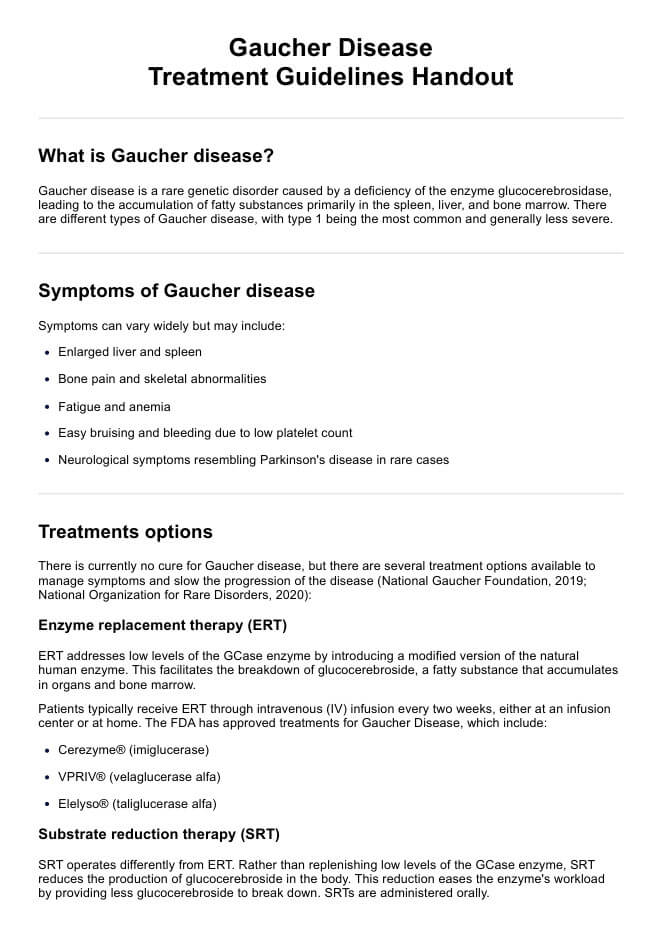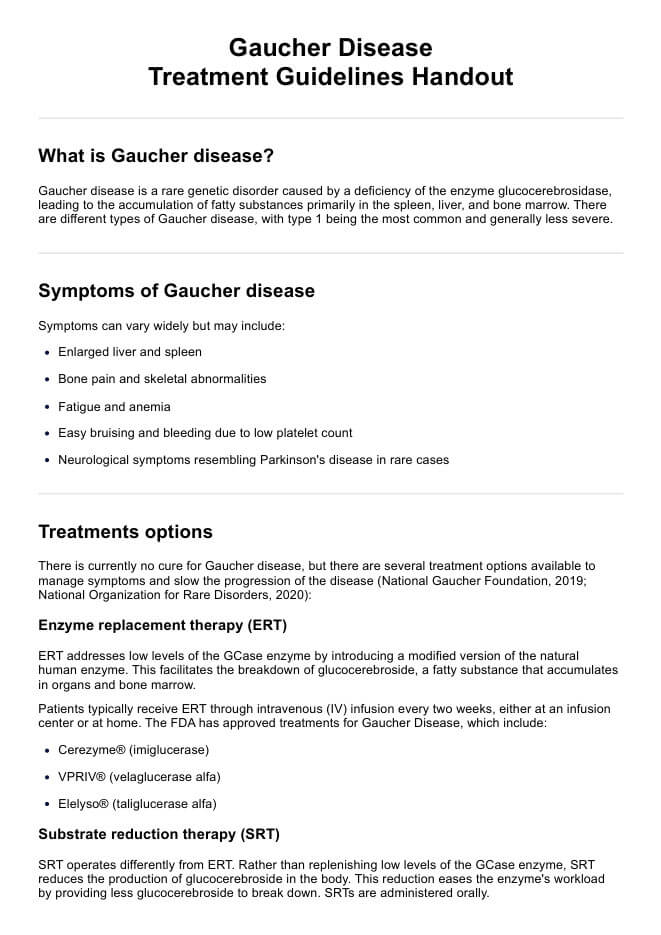Gaucher Disease Treatment Guidelines
Access Carepatron's free downloadable PDF guides on Gaucher Disease treatment guidelines to understand this rare genetic disorder and its management options.


What is Gaucher disease?
Gaucher disease, a rare inherited disorder, results from a deficiency of the enzyme glucocerebrosidase, essential for breaking down certain fatty substances in the body. Named after the French physician Philippe Gaucher, who first described it in 1882, the disease manifests in three main types—Types 1, 2, and 3—each differing in severity and age of onset.
This deficiency leads to the abnormal accumulation of fatty substances, primarily in the spleen, liver, and bone marrow. There are several types of Gaucher disease, with type 1 being the most common and typically less severe.
Symptoms of Gaucher disease type 1 may experience bone marrow pain, fatigue, and an enlarged liver or spleen. In some cases, mild symptoms may not manifest until later in life, complicating diagnosis. Gaucher disease type can also lead to complications affecting the bones, blood, and organs.
Gaucher disease and Parkinson's disease are distinct conditions with some overlapping biochemical pathways but different clinical presentations and underlying causes. Gaucher disease is a rare genetic disorder caused by mutations in the GBA gene, leading to a deficiency in the enzyme glucocerebrosidase. This deficiency results in the accumulation of glucocerebroside, primarily in the spleen, liver, and marrow.
Individuals with Gaucher disease type 1 face risks related to organ enlargement, bone disease leading to osteoporosis and fractures, and, in severe cases, neurological damage.
Gaucher Disease Treatment Guidelines Template
Gaucher Disease Treatment Guidelines Sample
Treatment of Gaucher disease
Effective treatment of Gaucher's disease involves addressing the enzyme deficiency and managing symptoms to improve quality of life. Here, we explore primary options for treatment of Gaucher disease:
Enzyme replacement therapy (ERT)
Enzyme replacement therapy is a cornerstone of Gaucher disease treatment, particularly for Gaucher disease type 1. It involves intravenous infusion of recombinant glucocerebrosidase to supplement the deficient enzyme in the body. ERT helps reduce the buildup of fatty substances in organs like the spleen and liver, alleviating symptoms such as enlarged organs and bone pain.
Substrate reduction therapy (SRT)
Substrate reduction therapy aims to decrease the production of the fatty substances that accumulate in Gaucher disease. This approach inhibits the synthesis of glucosylceramide, slowing Gaucher disease type progression. SRT is an alternative treatment for patients who may not tolerate or respond adequately to ERT.
Management of symptoms
In addition to specific therapies targeting the underlying cause of Gaucher disease type, symptom management is crucial. This includes pain relief for bone pain, addressing anemia and other blood cell complications, and monitoring and managing organ enlargement. Regular medical checkups and tests like magnetic resonance imaging can also be done.
Genetic counseling
Genetic counseling plays a vital role in Gaucher disease management. It provides information and support to individuals and families regarding early childhood inheritance patterns, prenatal testing options, and family planning decisions. This proactive approach can help manage the risk of passing on the disease to future generations and ensure informed decision-making regarding treatment options.
Addressing neurological symptoms
While primarily affecting organs and bones, Gaucher disease type can occasionally present with neurological symptoms of Gaucher disease similar to those seen in Parkinson's disease. Managing these symptoms may require a multidisciplinary approach involving neurologists and other specialists, ensuring comprehensive care for affected individuals.
How to use our treatment guidelines handout template
Carepatron's Gaucher Disease Treatment Guidelines Handout provides medical professionals with a structured approach to managing Gaucher disease effectively. Here’s how to utilize this resource:
Assess patient’s condition
Begin by reviewing the patient's medical history, symptoms of Gaucher disease, and any relevant family history. Assess the type and severity of Gaucher disease (e.g., type 1) to tailor treatment recommendations accordingly.
Customize treatment plan
Use the template to outline personalized treatment goals and strategies based on the patient’s clinical course and specific needs. Include details on enzyme replacement therapy (ERT) or substrate reduction therapy (SRT), considering early treatment to prevent skeletal abnormalities and maintain blood cell health.
Educate patients and families
Share the guidelines with adult patients with Gaucher disease type 1 and their families to ensure they understand the importance of ongoing treatment and regular follow-ups. Provide information on prenatal diagnosis options for families planning future pregnancies.
Monitor and adjust
Regularly monitor the patient’s response to treatment, including bone density and organ function assessments. Adjust the treatment plan as needed to optimize outcomes and prevent Gaucher disease progression.
Benefits of using this handout
The Gaucher Disease Treatment Guidelines Handout by Carepatron offers numerous advantages for medical professionals managing Gaucher disease. Firstly, it provides a standardized approach to treatment, ensuring consistency and quality of care across different healthcare settings.
Secondly, this resource enhances patient education and engagement. It is a comprehensive tool for explaining treatment options, expected outcomes, and the importance of adherence to therapy. This empowers patients and their families to actively participate in their care, fostering a collaborative healthcare environment.
Take advantage of Carepatron's Gaucher Disease Treatment Guidelines Handout to streamline patient management and improve treatment outcomes. Download our handout today and optimize your approach to managing Gaucher disease.
Commonly asked questions
Yes, with proper treatment and management, many individuals with Gaucher disease can lead relatively normal lives, though ongoing medical supervision is essential.
Gaucher disease is managed through ERT or SRT, regular monitoring of symptoms, and addressing complications as they arise.
ERT is considered the first-in-line treatment for Gaucher disease. It aims to supplement the deficient enzyme and reduce the buildup of fatty substances.
Medications commonly used for Gaucher disease include enzyme replacement therapies (ERTs) like imiglucerase, velaglucerase alfa, and taliglucerase alfa, which are administered intravenously to replace the deficient enzyme.







































































































